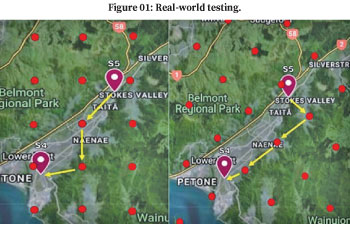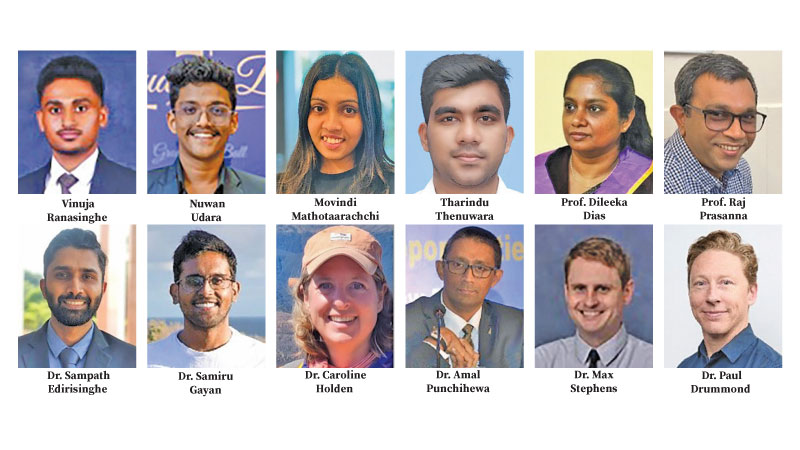 In a breakthrough, researchers at the University of Moratuwa, in collaboration with Massey University of New Zealand, have developed a novel low-latency data communication solution that can be integrated with earthquake early warning systems. This advancement could save countless lives by delivering faster and more reliable alerts. This new system uses LoRa technology to send warning messages even when the internet is down – a critical feature when disaster strikes.
In a breakthrough, researchers at the University of Moratuwa, in collaboration with Massey University of New Zealand, have developed a novel low-latency data communication solution that can be integrated with earthquake early warning systems. This advancement could save countless lives by delivering faster and more reliable alerts. This new system uses LoRa technology to send warning messages even when the internet is down – a critical feature when disaster strikes.
The problem with current systems
Imagine being caught off guard by a massive earthquake. Roads crack open, buildings shake violently, and in the chaos, telecommunication networks fail. This is the terrifying reality in many earthquake-prone regions. Even the most advanced early warning systems, which rely on the internet to send alerts, can become useless when networks crash during a disaster.
To tackle this problem, researchers have designed a new way to send warnings that do not depend on the internet at all. Instead, it uses a wireless technology called LoRa which stands for “Long Range”, to keep messages flowing, even when conventional communication systems break down.
How does the new system work?
The new system does not replace the existing Earthquake Early Warning (EEW) network – it strengthens it. Developed by a team of researchers, this novel communication layer is based on LoRa (Long Range) technology and is designed to work hand-in-hand with the decentralised EEW architecture already operating in parts of New Zealand.
In this enhanced setup, ground motion sensors installed in community homes detect earthquakes and generate alerts locally, using an algorithm known as PLUM (Propagation of Local Undamped Motion). These alerts are then transmitted not over the internet which is often the first thing to fail in a disaster — but through a custom-built, LoRa-based wireless network.
This is where the breakthrough comes in: LoRa was originally designed for long-range, low-power applications, not high-speed emergency messaging. To overcome this, the team created a multi-hop broadcast network. Instead of sending an alert directly from one sensor to another over long distances (which would be slow), messages are passed rapidly from device to device in short bursts. This leapfrogging reduces delay and dramatically improves reliability.
In field tests using an affordable LoRa device through detailed simulations, the system was able to deliver warning messages across a 30-kilometre radius in as little as 2.4 seconds. That’s fast enough to give communities a few critical seconds to take cover even when traditional networks are down.
What’s more, the system is resilient. Messages do not rely on a single path; if one device is blocked, others can take over. This flexibility ensures the network remains operational even if some sensors are damaged or disconnected during a quake.
By integrating seamlessly with the earlier EEW work, this LoRa-based communication layer offers a cost-effective, internet-free backup that can keep communities connected when it matters most.
Why LoRa makes a difference
LoRa technology was originally developed for low-power, long-range communication. It’s often used for things like tracking shipments or monitoring weather conditions. Now, it’s being adapted for earthquake warnings because of its ability to send messages over long distances using very little power.
One challenge with LoRa is that it’s not the fastest technology out there. It takes a bit longer to send data compared to the Internet. But by using short, rapid “hops” between nearby devices, the system keeps the total delay remarkably low. The system can send a warning across a 30-kilometre area in just 2.4 seconds. That’s fast enough to give people precious time to take cover.
Real-world testing
The team behind this innovation didn’t just build a theoretical model. They put it to the test. In a series of field experiments, they set up small networks using affordable devices called Lilygo LoRa32. These devices, which look a bit like small circuit boards with antennas, were placed at various heights and locations to see how well they could relay messages in a realistic environment.
The tests took place in areas with obstacles like buildings and trees that could block signals. Despite these challenges, the network worked surprisingly well. Some devices managed to deliver messages with a success rate of up to 90%, while others were slightly lower, depending on their location and surroundings.
The experiment showed that the multi-hop network could reliably send warnings even when some devices were temporarily blocked or out of range. This redundancy is crucial, as it ensures that the system remains effective even if some devices fail during an earthquake.
Why Is this technology so important?
During an earthquake, every second counts. Early warnings give people just enough time to take protective actions like “Drop, Cover, and Hold On.” They can also trigger automatic safety measures in critical infrastructure, such as stopping trains, shutting down gas lines, or warning hospital staff to secure patients.
The traditional centralised systems, which rely on internet connectivity, are prone to failure during major earthquakes when communication networks are disrupted. In contrast, this new LoRa-based system keeps running even if the internet goes down, making it a reliable solution for communities around the world.
 The system is designed to be cost-effective, making it accessible to communities that might not be able to afford more expensive, high-tech warning systems. This is especially important in countries that are vulnerable to earthquakes but lack the financial resources to invest in large-scale infrastructure.
The system is designed to be cost-effective, making it accessible to communities that might not be able to afford more expensive, high-tech warning systems. This is especially important in countries that are vulnerable to earthquakes but lack the financial resources to invest in large-scale infrastructure.
Community involvement and flexibility
One of the unique aspects of this system is how it encourages community involvement. Because the sensors are relatively affordable and easy to install, local communities can take an active role in building their safety networks.The network itself is also highly adaptable. As more sensors are added, the system becomes stronger and more reliable. If some sensors are knocked out during an earthquake, others can still carry the warning message through alternative routes. This flexibility makes the system not only resilient but also scalable, allowing it to grow as communities invest in more sensors over time.
Limitations and future work
While the system is incredibly promising, it’s not without challenges. One of the main hurdles is optimising the network to handle large amounts of data without causing message collisions or interference. The researchers are also working on ways to make the devices even more energy-efficient, allowing them to last longer on battery power.
In the future, the team hopes to conduct larger-scale field trials and continue fine-tuning the technology. They are also exploring ways to integrate the system with existing warning infrastructures to provide a multi-layered approach to public safety.
A step towards safer communities
This new multi-hop LoRa-based earthquake warning system is a game-changer in disaster preparedness. By using low-cost technology and innovative network designs, it offers a practical, resilient solution to a long-standing problem.
In an age where natural disasters are becoming more frequent and severe, this technology represents a crucial step forward in protecting lives and reducing the devastation caused by earthquakes.
As it continues to develop, it holds the potential to revolutionise how communities prepare for and respond to one of nature’s most destructive forces.
For more insights into this breakthrough, the complete research paper – “Rapid and Resilient LoRa Leap: A Novel Multi-Hop Architecture for Decentralised Earthquake Early Warning Systems”- is available in the MDPI Sensors journal.
It presents the technical foundations and experimental findings that bring this innovative system to life.
Contributors:
Vinuja Ranasinghe, University of Moratuwa, Sri Lanka.
Nuwan Udara, University of Moratuwa, Sri Lanka.
MovindiMathotaarachchi, University of Moratuwa, Sri Lanka.
Tharindu Thenuwara, University of Moratuwa, Sri Lanka.
Prof. Dileeka Dias, University of Moratuwa, Sri Lanka.
Prof. Raj Prasanna, Massey University of New Zealand
Dr. Sampath Edirisinghe, University of Sri Jayawardenepura, Sri Lanka.
Dr. Samiru Gayan, University of Moratuwa, Sri Lanka.
Dr. Caroline Holden, SeismoCity Ltd., New Zealand.
Dr. Amal Punchihewa, ADP Consultancy, New Zealand
Dr. Max Stephens, University of Auckland, Auckland, New Zealand.
Dr. Paul Drummond, Canterbury Seismic, New Zealand.








